Neapolitan Mastiff: description and recommendations for content

Each dog breed stands out for its unique exterior features. Among the available variety, there are miniature animals, as well as large four-legged pets, which become faithful companions for humans. The latter category includes the Neapolitan Mastiff, which stands out among the dogs for its impressive size.
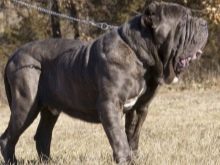
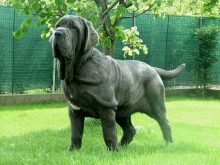
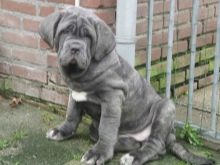
Peculiarities
The most striking distinctive feature of the dog of this breed, which sets it apart from other relatives, is the head. She, like other varieties of mastiffs, is very massive and has numerous hanging skin folds. This feature of the exterior is also called "wrinkles".
Despite its large size, unlike the rest of its congeners, Neapolitano demonstrates a rather peaceful disposition, in addition, in addition to the husky, it is these four-legged animals that are considered natural babysitters for children of any age.

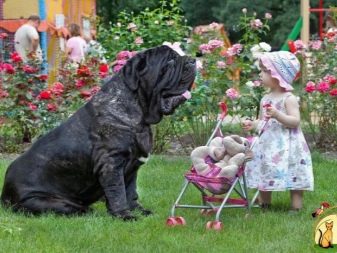
Owners and dog handlers appreciate one of the largest dogs for the following qualities:
- calm and stable psyche;
- patience;
- loyalty to the owner and his family members;
- ease of care and maintenance;
- cleanliness of the dog;
- quick wits and intelligence.
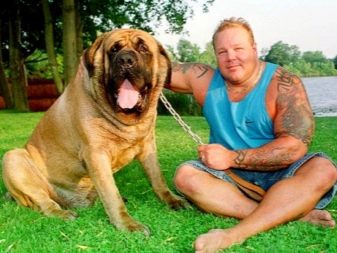
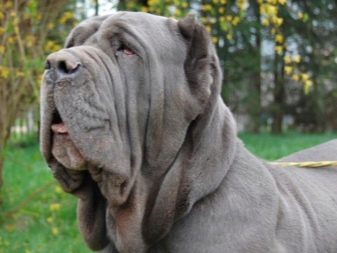
History of origin
The Neapolitan Mastiff is a breed that has a long history. Mentions of such animals are found in sources relating to the period of the military campaigns of Alexander the Great. It was this dog that the Indian king presented as a gift to the conqueror.
Now individuals noted in history are ranked among the progenitors of modern Neapolitano.Images of large dogs, similar in exterior to a mastiff, were also found on ancient Persian bas-reliefs. In the Roman Empire, large animals were on a special account, therefore they were used as fighting dogs, as well as guards for private property. After the fall of Rome, Neapolitans were still found in various parts of Italy, but the animals were very often interbred with Iberian mastinos. During the war years, the breed practically died out.
The appearance of dogs in Europe dates back to a new era, when four-legged guards were brought to the mainland together with other valuable goods by Phoenician seafarers and traders.
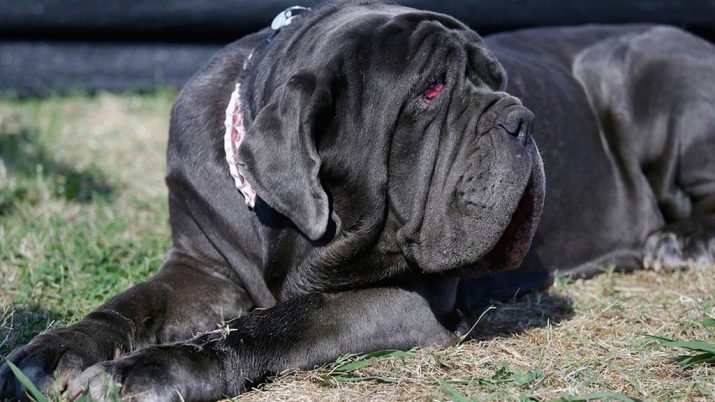
The further formation of the breed, as well as the consolidation of the exterior characteristics took place already on the mainland, wherethe animals, in the process of adapting to the new climate and due to crossing with local breeds, underwent some changes.
Work on breeding a stable population of large dogs began much later. Cynologist Piero Skontzane for a long time selected individuals with homogeneous characteristics among the remaining representatives. His attempts were crowned with success, due to which in 1949 the first offspring from purebred parents were bred in the nursery. In the same year, the standard for the breed was approved, over time, various changes were made to it.
The latest version of the requirements for the Neapolitan Mastiff breed was registered in 1999.
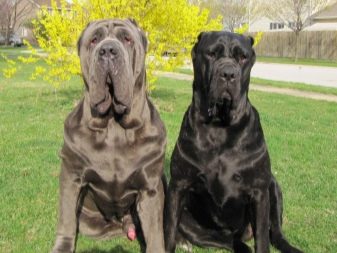
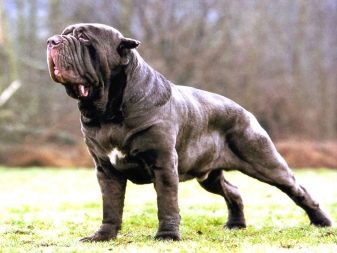
Description of the breed
The characteristics of the breed include several basic criteria, they relate to the exterior and temperament of animals.
Appearance
The height of adult males should be 65-75 centimeters, bitches at the withers should measure from 60 to 80 centimeters. The weight of male animals varies between 60-70 kilograms, bitches can weigh 50-60 kilograms.
Consider the distinctive features of dogs.
- Head. The animal's skull and muzzle are large; the bulk of the skin folds is concentrated on the forehead and cheeks. Also, the exterior of the dog should be complemented by drooping and fleshy lips. The muzzle is similar in shape to a square, but without pronounced sharp corners. The nose, like all other parts of the head, is large, with wide nostrils, and the dog's jaws are no less impressive.
The bite of the animal is scissor, the canines are medium in size. The eyes are closed by thick, rounded eyelids. The color of the iris is predominantly darkas a rule, its color is in harmony with the color of the dog's coat. But the ears do not stand out for their size, they fit quite tightly to the cheeks, have a triangular shape with rounded edges.
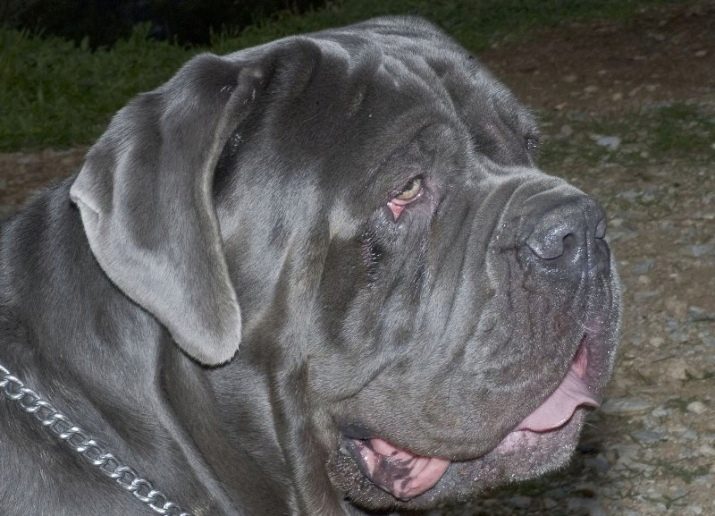
- Neck... The head passes rather smoothly into the cervical region. The neck of the mastiff is small, but has pronounced muscles. The skin in this part also folds into "wrinkles".
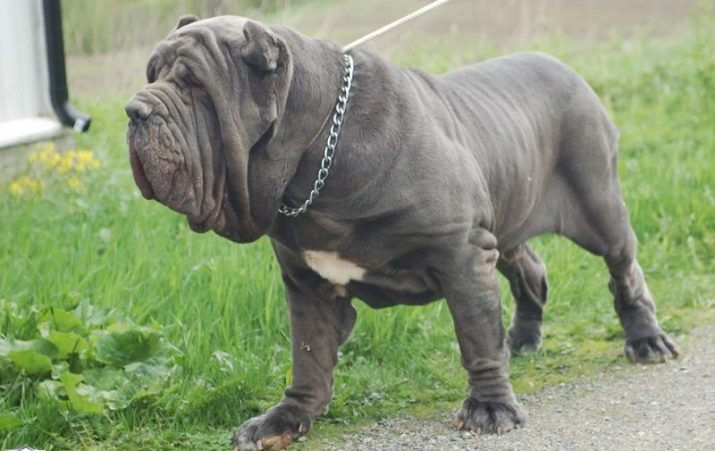
- Back... The trunk and back are highlighted by a well-visible muscular corset. The length of the back is medium, but the width is quite impressive. The loin should protrude slightly.
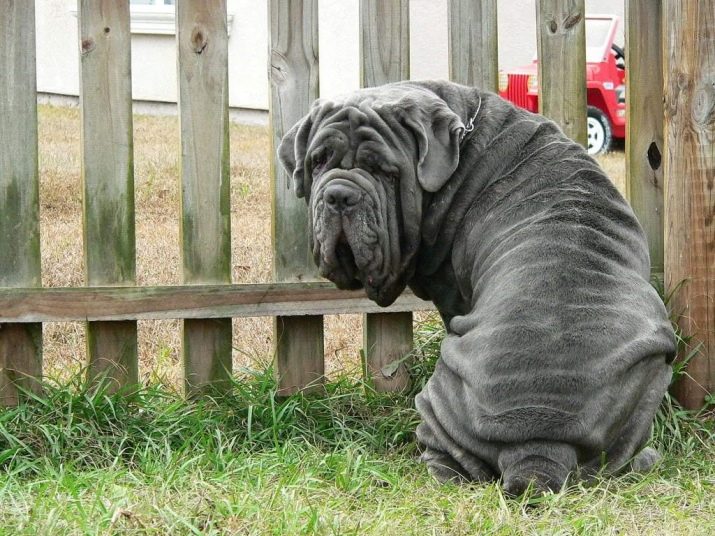
- Breast. The rib cage of a purebred dog is long and rather wide. In an animal that is not obese, the ribs and muscles should be clearly visible, the belly of the mastiff should be tucked up.
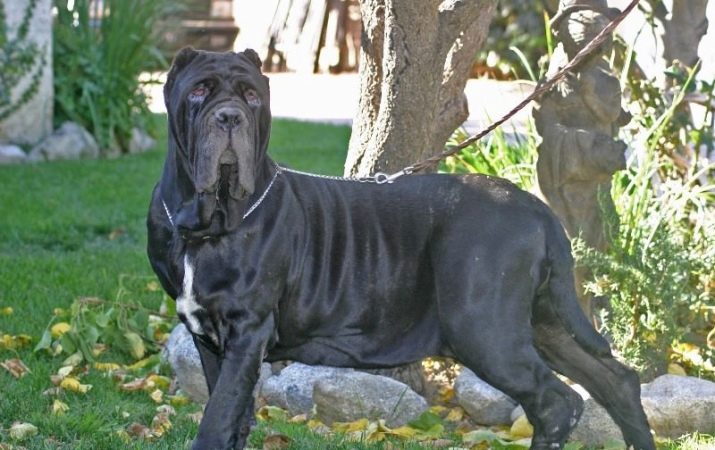
- Croup. This part of the animal's body has a slight bevel, it is distinguished by its width and developed muscles.
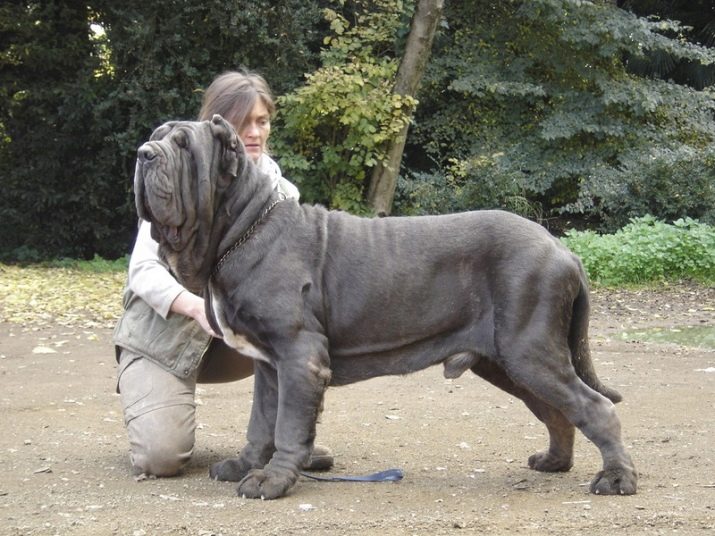
- Tail. At the very base, the tail is usually slightly wider than at the end. This form is called saber. In the active state, the tail is at the level of the back or slightly higher.
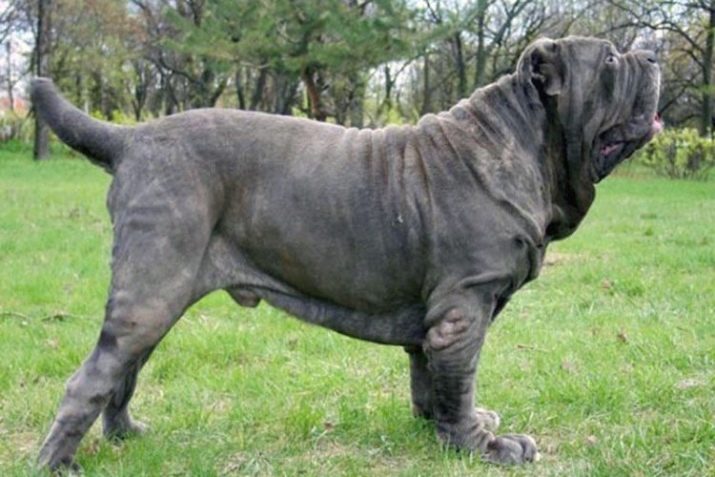
- Limbs... Feet are set straight, they are large and strong, with a well-developed muscular system. The fingers are pressed together, therefore, they resemble a dense "lump".
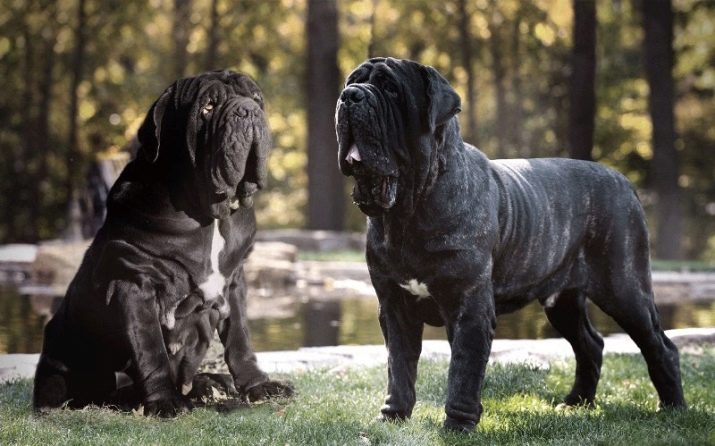
The size of the dog determines the innate endurance and strength, which is also an important trait of the breed.
The peculiarities of the coat color of the Neapolitan Mastiffs have some approved standards. The coat of dogs protects animals from external factors, it adheres quite tightly, but dogs have no undercoat.It has been noticed that the hairs of males are more rigid. Acceptable colors for the breed are:
- black and gray;
- Brown;
- walnut;
- pale yellow;
- dark red;
- lead-silver.
Also sometimes there are dogs with a coat color "Isabella". In the color of mastiffs, several colors can prevail with a smooth transition from one to another. The spots in the thoracic region and paws are not considered as deviations.

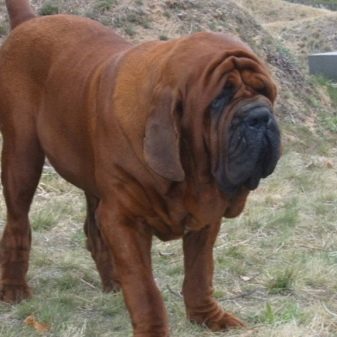
Character
The Neapolitan Mastiff was originally positioned as a watchdog, he retained similar instincts today. That's why the animal has a pronounced makings of a guardthat manifest in relation to its territory and owner / family members. At the same time, even as puppies, dogs become strongly attached to their breeder, maintaining this heart habit until old age. They are friendly towards familiar people, willingly take part in active games.
In relation to strangers, dogs will show suspicion, but in the absence of an obvious threat, a four-legged friend may simply not notice a new person. It is very difficult to get along with other animals, because he is jealous of his breeder, which inevitably leads to conflicts.

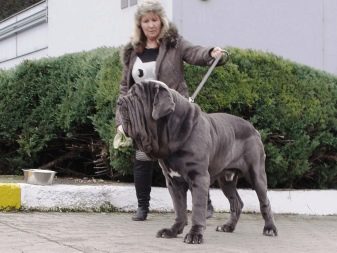
The dog is distinguished by highly developed intellectual abilities, therefore it lends itself well to training, however, up to 2 years old it will try to dominate, therefore needs regular training and education. Mastiffs have an excellent memory, so ill-wishers will be remembered for a very long time, but vindictiveness is not inherent in them.
This dog will not bark in vain. Mastiffs quickly adapt to new conditions and stand out for their resistance to stress. Alone and in a confined space, the pet can get bored and depressed.
With proper training, Neapolitans can become patient guides for people with disabilities.

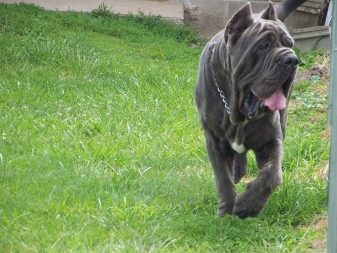
Feeding
An important point in keeping a large dog is a well-designed diet that will ensure the health, activity and longevity of the animal. As a rule, in addition to mother's milk, the puppy's body will need additional complementary foods no earlier than 20 weeks of age. During this period, dogs are actively gaining weight, and they also begin the process of teething of their first teeth, which makes the feeding process less pleasant for the mother.
The bitch may occasionally regurgitate undigested food, which becomes a milk substitute for the growing offspring. The breeder will need to offer the puppies during this period milk formulas that have a similar chemical composition to breast milk.

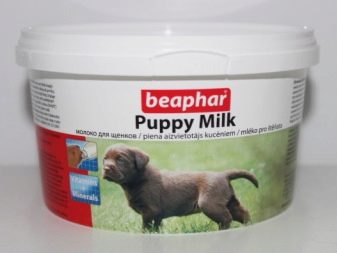
Dogs are weaned at 4 months of age. Then the puppy must be fed at least 4 times a day. It is recommended to introduce raw liver, fermented milk products, fish oil, yeast and eggs into the diet of a young dog. By 6 months, you can cut your meals up to 3 times. An adult dog is considered after a year, then the breeder must feed it twice a day - in the morning and in the evening.
Owners of the Neapolitan Mastiff can make it easier to feed it if you purchase ready-made industrial dog food. However, it is important to choose the right product option from the assortment offered in the store. The composition of the feed must necessarily contain the meat component, as well as the maximum amount of nutritional components.
Today in pet stores there are foods designed for large breeds of dogs that are suitable for a mastiff.
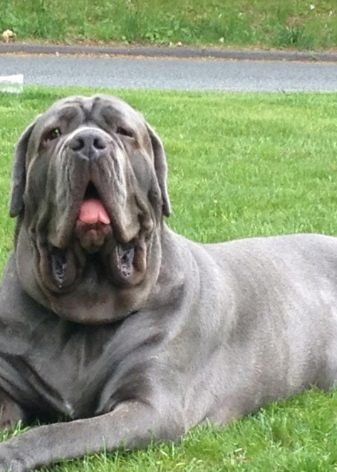
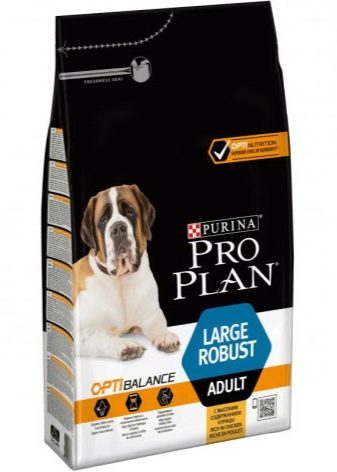
If the dog eats natural food, then the following foods should be in its diet:
- meat and offal - rabbit, beef, turkey, chicken;
- cereals - rolled oats, rice, buckwheat;
- vegetables (excluding potatoes);
- eggs;
- fermented milk products;
- sea fish.
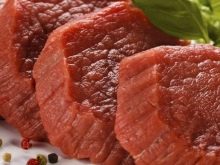
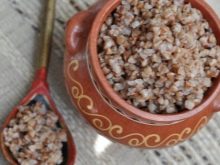
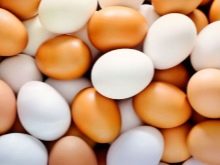
The introduction of vitamin and mineral complexes into the menu is mandatory.
Bones from fish and chicken, pickles, smoked meats and spices, confectionery will be prohibited for the introduction of the mastiff into the diet. The animal should always have free access to water.
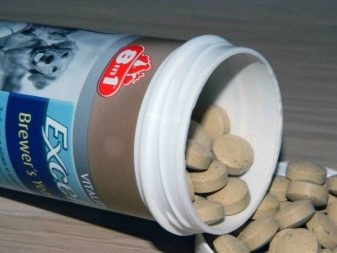
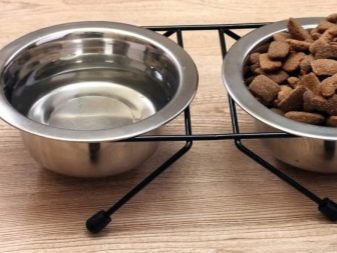
Care
The average life span of a four-legged pet is 10-15 years, but these numbers largely depend on proper care. Since the breed has such features as deep skin folds into which dirt will clog, the dog will need regular grooming in the area of skin wrinkles. Also, in the process of caring for a mastiff, the breeder will need to regularly perform such activities.
- The animal needs to be massagedto disperse the blood under the skin. Doing this will help establish the blood flow that feeds the dog's coat. In addition, regular treatments will be an excellent prevention of eczema. You can do the massage with your hands without using any additional devices.
Some breeders use a stiff mitten or silicone brush. All parts of the dog's body need to be massaged with the exception of the muzzle.
- After a walk, it is necessary to carefully examine the limbs of the four-footed pet.... This is due to the likelihood of damage to the pads on the paws due to the fact that the Neapolitano has a rather sweeping gait. Having found any abrasions or wounds, the owner must treat them with a disinfectant.
- In light of the lack of undercoat in dogs of this breed, skin parasites can multiply in the "wrinkles", especially in the summer. Therefore, in addition to inspection and cleaning, it will be necessary to treat the folds with compounds against blood-sucking pests.
- Your dog's ears will need to be cleaned weekly. For these purposes, you can use a cotton pad dipped in plain water or with the addition of an antiseptic. As a prophylaxis for ear mites, it is recommended to use specialized drops for animals, which are sold in a veterinary pharmacy.
- The dog is usually bathed in the warm season. For hygiene procedures, you can use a hypoallergenic shampoo designed for children or animals. The rest of the time, cleansing the limbs, chest and abdomen with a regular rinse will suffice. After bathing, the dog should not be dried with a hairdryer; it will be enough to wipe the animal with a cotton towel. Frequent water treatments are not recommended for the dog as they remove the natural protective layer of fat on the animal's skin.
- Claws need to be trimmed as they grow back, as a rule, such events are held monthly using a special guillotine claw cutter. Only the dead hollow tissue at the end of the nail can be removed. Cutting off a living area can provoke blood poisoning, so you cannot disturb the claw under the plate.
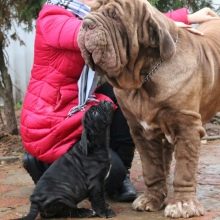
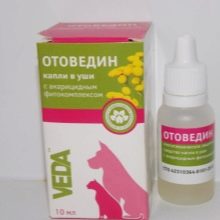
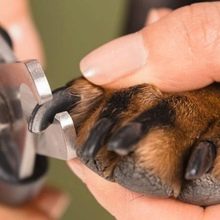
When keeping a dog in an apartment, it is necessary to highlight a separate sleeping place, as well as a feeding area. The litter or rug should be cleaned regularly, no residues should accumulate in the dishes after eating.
Puppies of this breed can suffer from viral and bacterial ailments, so it is important for the breeder to vaccinate the animal for up to 3 months. Usually the dog is vaccinated against hepatitis, plague, leptospirosis and parvovirosis. Vaccination against rabies is compulsory for a pet up to 12 months. Further vaccinations are done every year. The best time for this procedure is spring.
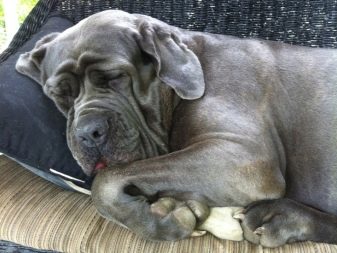

Based on its physiology, the Neapolitan Mastiff is susceptible to the following ailments:
- volvulus, which is most common in adult dogs;
- cardiopulmonary filariasis, which is transmitted through the bite of blood-sucking parasites.
In general, Neapolitano stands out for its strong immunity, so it rarely gets sick. The most vulnerable dog will be in the first year of life, so the breeder is advised to pay maximum attention to the pet.
At the first manifestations of abnormalities in behavior, the dog should be immediately shown to the veterinarian.
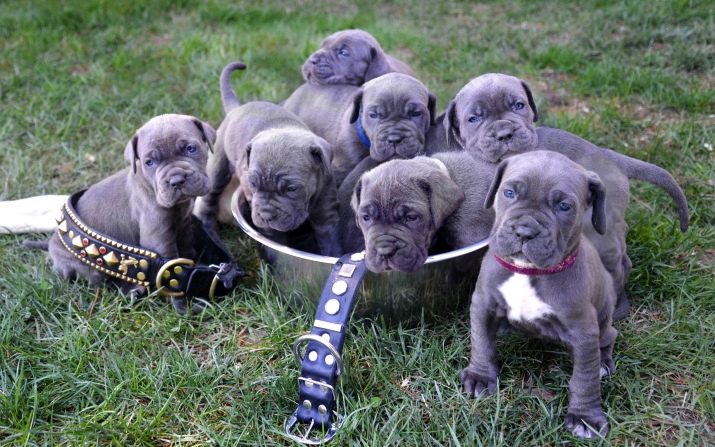
Education and training
In the process of training and working on the upbringing of Neapolitano, a rude attitude towards the animal and the manifestation of physical strength are prohibited. It will be enough for the pet to raise the owner's voice to understand its mistake. The maximum punishment for him can be a slap on the back with a rolled-up newspaper.... Animals quickly realize their mistake, but do not take offense, but try to make amends.
Dogs need space to be able to move and constantly learn something new. That's why the animals kept in the apartment will require long walks and outdoor training.
During training, all commands to the dogs should be given with a firm voice, but without aggression or anger, the phrases should consist of one word. Everything that the breeder says during training must be done, otherwise the dog will not recognize the authority of the person.
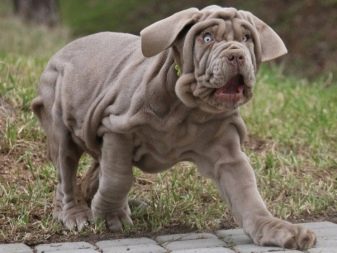
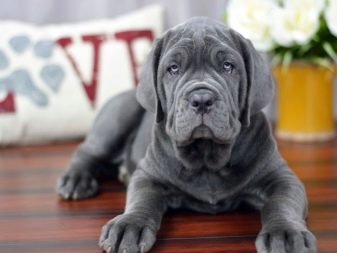
The mastiff, which is used to guard private property, can be taught to rush at strangers using a specific command, and this word can be any word inserted into the conversation. Also, an imperceptible touch to the animal will serve as a similar signal.
The puppy should first of all be taught to walk on a leash next to the owner. At first, the dog will tear in different directions, therefore, for large dogs it is recommended to purchase a collar in the form of a chain. Such a device will quickly wean the pet from disobedience. It is forbidden to keep a mastiff in the yard on a chain, since such a lifestyle will make the dog aggressive, and problems with the psyche of the animal are also possible.
It is important that the prohibitions imposed on the dog in the home are controlled by all members of the family. If someone begins to allow something that is not allowed, the dog may not recognize the authority of the prohibitor in the future.
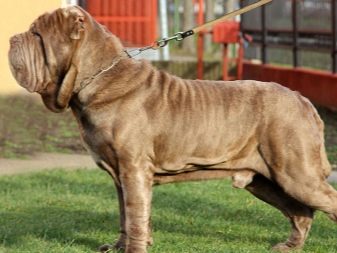
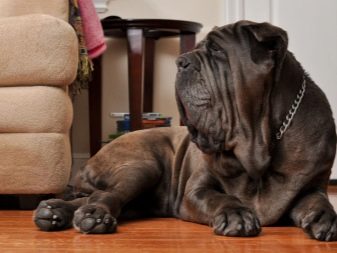
It is recommended to start training and learning from 1.5 months of age. First, the pet must learn to respond to its nickname. The training should be regular. If the dog starts to react, he definitely needs to be encouraged.
Up to 3 months of age, a mastiff can be raised at home, after which a growing dog should be enrolled in training sessions if the breeder has minimal experience in raising four-legged dogs. Dogs that will subsequently carry out security guard duty must be brought up under the guidance of an experienced dog handler. The animal may need to go through special courses.
Attending additional classes will teach your dog:
- walk next to the owner without a leash;
- understand the breeder not only with voice commands, but also with hand and even eye movements;
- the animal will know its place;
- learn basic commands;
- will be trained with various shells.
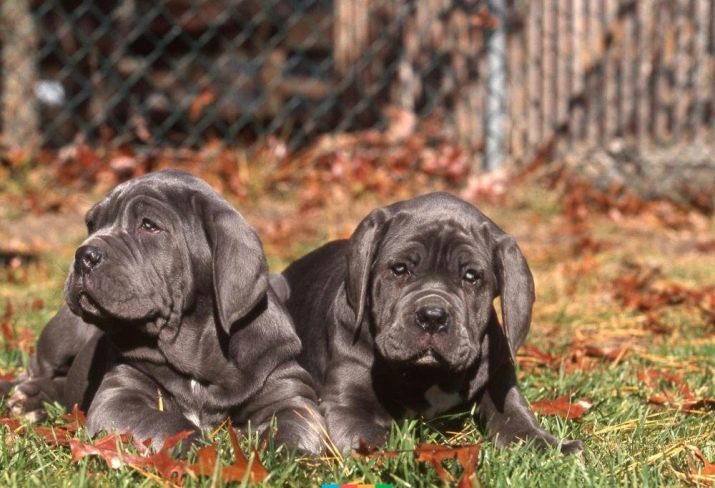
Breeding
Healthy Neapolitano dogs should have their first estrus between 6 months and a year. Deviations from this value will indicate possible problems or pathologies in the development of the reproductive organs. It is not recommended to mate in the first heat... Cynologists and veterinarians advise to wait until the dog is as strong as possible. Therefore, the best time for mating will be the second or third heat.
A suitable pair for a dog must be looked after in advance, it would also be more correct to immediately discuss the rights to future offspring. Usually mating is carried out after long walks with the animal.
The first mating is best done under the supervision of an experienced instructor to avoid unforeseen situations and failures.
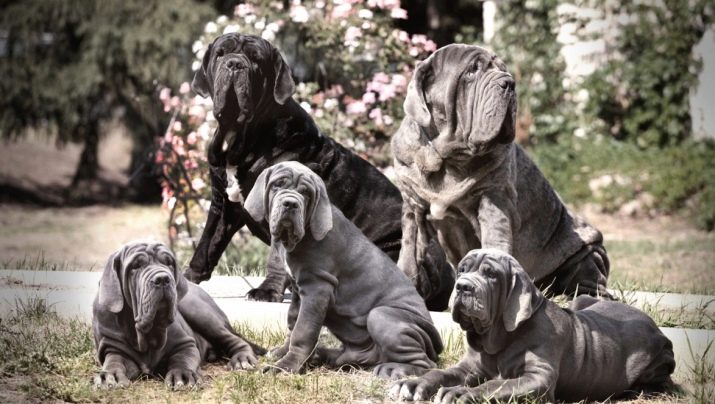
For more on the characteristics of the breed, see the next video.






































